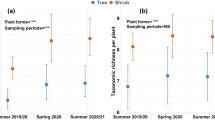Abstract
Disturbance of flora from utility construction tends to generate new plant growth. This growth changes productivity, diversity, and stability. Although the enhancement of vegetation may balance out the biomass destroyed by the original disturbance, it often adversely affects the quality of the vegetation. Percentage composition of the dominant long-lived perennials combined with quantitative measures are used to assess longterm effects of utility corridor construction. Differential effects of enhancement of vegetation are found along road edges, enhancement under wires of powerlines, and over trenches dug for pipelines. Areas under powerline pylons seem to receive the greatest damage and also show the most variable recovery of vegetation. Significant recovery rates are noticeable where the time span between year of construction has allowed for considerable regrowth of the older corridor. Recovery rates depend on soil type, landform, and other physical features of the disturbed sites. Drastic disturbance in one area or transect site may impede vegetation recovery, whereas slight disturbance might enhance vegetation in another, tending to offset the effect of the drastic disturbance. Disturbed areas and control areas may appear to have similar vegetation covers, biomasses, and densities, but these similarities often vanish when one examines qualitative aspects, such as proportion of long-lived species and presence of characteristic dominants.
Similar content being viewed by others
Literature cited
Brower, J. E., and J. H. Zar. 1977.Field and laboratory methods for general ecology. Wm. C. Brown Co., Dubuque, Iowa.
Brum, G. D. 1979.Coolwater-Kramer 220 kV transmission line revegetation study. Southern California Edison Co. Semiannual Progress Report III.
Bureau of Land Management. 1979.Weight density values for perennial plants of the Colorado and Mojave Deserts, California Desert Plan Program, Bureau of Land Management, Riverside, California, File report.
Garcia-Moya, E., and C. M. McKell. 1970. Contribution of shrubs to the nitrogen economy of a desert-wash plant community.Ecology 51: 81–88
Johnson, H. B., F. C. Vasek, and T. Yonkers. 1975. Productivity, diversity and stability relationships in Mojave Desert roadside vegetation.Bulletin of the Torrey Botanical Club, 102: 106–114.
Lathrop, E. W. 1978.Plant response parameters to recreational vehicles in the California Desert Conservation Area. Contract No. CA-060-CT7-2824, Desert Plan Program, Bureau of Land Management, Riverside, Ca. Final Report.
Lathrop, E. W. 1979.Plant response studies to utility construction in the Mojave Desert, California. Contract No. Ca-060-CT8-53. Desert Plan Program, Bureau of Land Management, Riverside, California. Final Report.
McIntosh, R. P. 1967. An index of diversity and the relation of certain concepts to diversity.Ecology 48: 392–404.
Muller, C. H. 1940. Plant succession in theLarrea-Flourensia climax.Ecology 21: 106–115.
Phillips, E. A. 1959.Methods of vegetation study. Holt, Rinehart, and Winston, New York.
Pickett, S. T. A. 1976. Succession: An evolutionary interpretation.American Naturalist 110: 107–119.
Shreve, F. 1942. The desert vegetation of North America.Botanical Review 8: 195–246.
Sokal, R. R., and F. J. Rohlf. 1969.Biometry. W. H. Freeman, San Francisco
Vasek, F. C. 1979. Plant succession in the Mojave Desert. In Wright, W. (Ed.),California deserts—Fragile ecosystems. Symposium proceedings, Southern California Botanists, Rancho Santa Ana Garden, Claremont, California.
Vasek, F. C., H. B. Johnson, and D. H. Eslinger. 1975a. Effect of pipeline construction on creosote bush scrub vegetation of the Mojave Desert.Modrono 23: 1–13.
Vasek, F. C., H. B. Johnson, and G. D. Brum. 1975b. Effects of power transmission lines on vegetation of the Mojave Desert.Madrono 23: 114–130.
Webb, R. H., and H. G. Wilshire. 1979. Recovery of soils and vegetation in the Mojave Desert ghost town.Journal of Arid Environments. In manuscript.
Author information
Authors and Affiliations
Rights and permissions
About this article
Cite this article
Lathrop, E.W., Archbold, E.F. Plant response to utility right of way construction in the Mojave Desert. Environmental Management 4, 215–226 (1980). https://doi.org/10.1007/BF01866455
Issue Date:
DOI: https://doi.org/10.1007/BF01866455




